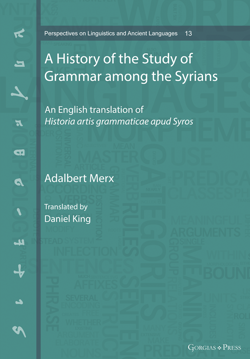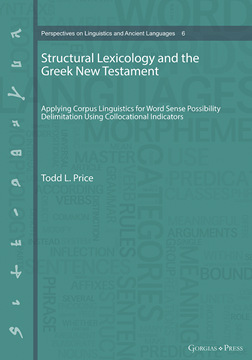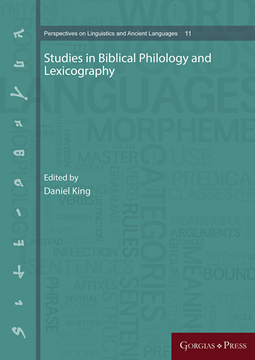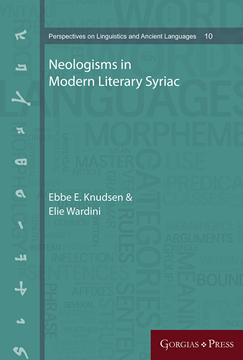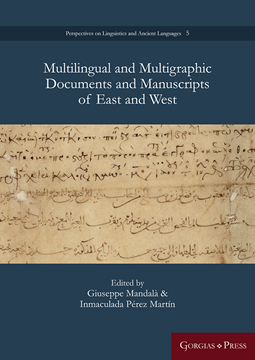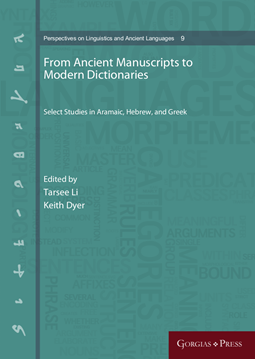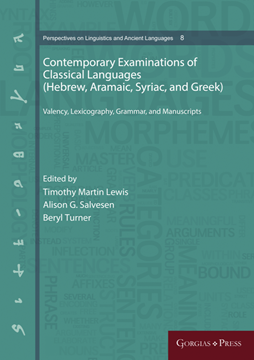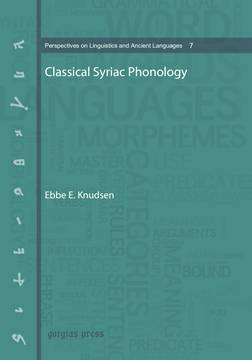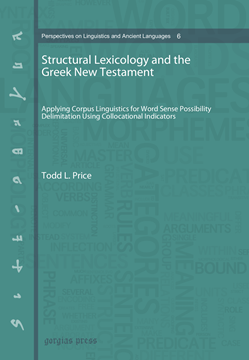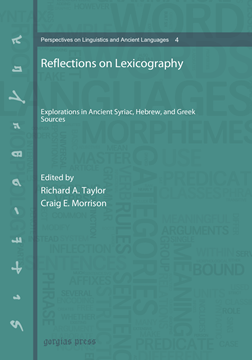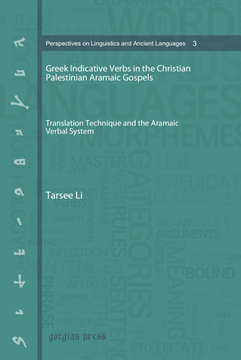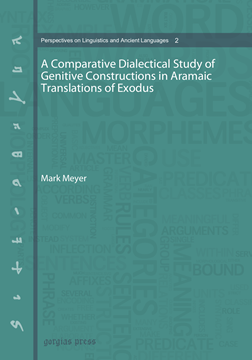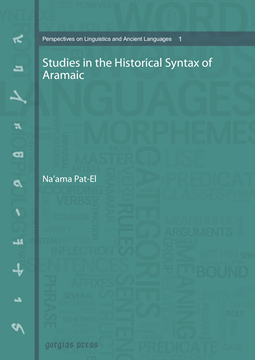Perspectives on Linguistics and Ancient Languages
Perspectives on Linguistics and Ancient Languages (PLAL) contains peer-reviewed essays, monographs, and reference works. It focuses on the theory and practice of ancient-language research and lexicography that is informed by modern linguistics.
Series Editorial Board
Lisa Agaiby
Terry Falla
Margherita Farina
Daniel King
Godwin Mushayabasa
Willem van Peursen (series editor)
Richard A. Taylor
In the Shadow of the Author
Contemporary Approaches in Translation, Lexicography and Linguistic Analysis
ISBN: 978-1-4632-4818-5
For centuries, scholars have approached ancient Hebrew and Syriac languages in an effort to better understand the voices of their authors and situate their writing in their appropriate historical and cultural contexts. In the Shadow of the Author continues this enduring practice by sharing contemporary approaches to uncovering meaning in historical texts from a linguistic perspective and with special emphasis on translation technique and methods in lexicography and linguistic analysis.
$114.95 (USD) $68.97 (USD)
Selected Studies in Ancient Language Lexicography, Linguistics and Translation
ISBN: 978-1-4632-4585-6
A collection of articles presented at the International Syriac Language Project (ISLP) meetings between 2017 and 2020, on the theme of lexicography, translation and text-critical matters across a range of ancient languages.
$114.95 (USD) $68.97 (USD)
Syriac Lexis and Lexica
Compiling ancient and modern vocabularies
Edited by Mara Nicosia
ISBN: 978-1-4632-4789-8
No time like the present, not even the glorious pioneering decades between 1870 and 1930, has seen such a high number of able and enthusiastic contributors to Syriac studies. 'Syriac Lexis and Lexica: Compiling ancient and modern vocabularies' brings together contributions from many different corners of lexicology and lexicography, and testifies to the richness of such subjects, which still offer scholars many possible approaches and research trajectories. This volume is the result of a round table 'Lexicologie et lexicographie syriaque', which took place at the 13th Syriac Symposium, held in Paris in July 2022.
$114.95 (USD) $68.97 (USD)
Investigating the Text-Hierarchical Structures and Composition of Numbers
By Gyusang Jin
ISBN: 978-1-4632-4483-5
The structure of the Book of Numbers and its division into textual units has long been of interest to scholars, and various theories have been put forward based on criteria such as time, location or theme. The present volume offers a syntactic-hierarchical analysis of the Book of Numbers, giving priority to syntax and secondary priority to participants and their roles.
$114.95 (USD) $68.97 (USD)
Mallephana Rabba
Aramaic Studies in Honor of Edward M. Cook
ISBN: 978-1-4632-4583-2
This volume of essays honors Edward M. Cook, Ordinary Professor of Semitic and Egyptian Languages and Literatures at The Catholic University of America. Cook is a leading figure in the vibrant and far-reaching field of Aramaic studies, and the essays reflect his range of interests, with lexical, linguistic, and literary analyses of dialects from the earliest inscriptions to the modern day.
$95.00 (USD) $57.00 (USD)
A History of the Study of Grammar among the Syrians
An English translation of Historia artis grammaticae apud Syros
By Adalbert Merx; Translated by Daniel King
ISBN: 978-1-4632-4197-1
An English translation of a Latin work on the Syriac grammatical tradition ('Historia artis grammaticae apud Syros') by the 19th-century German theologian and linguist, Adalbert Merx.
$95.00 (USD) $57.00 (USD)
Structural Lexicology and the Greek New Testament (paperback)
Applying Corpus Linguistics for Word Sense Possibility Delimitation Using Collocational Indicators
ISBN: 978-1-4632-4220-6
This study demonstrates a method for using corpus linguistics to disambiguate polysemes in the Greek New Testament. Included are several examples applying the method to exegetically problematic texts.
$48.00 (USD) $28.80 (USD)
Studies in Biblical Philology and Lexicography
Edited by Daniel King
ISBN: 978-1-4632-4035-6
This volume offers papers that emerged from the meeting of the International Syriac Language Project (ISLP) which took place at Stellenbosch University, South Africa, in September 2016, and at the Humboldt-Universität zu Berlin, in August 2017. The ISLP invites research not only into Syriac, but extends its range to all ancient language lexicography. Hence its proceedings enrich the whole field of Syriac, Hebrew, and Greek lexicography. The ISLP especially encourages research into the interfaces between these languages, and hence the current volume contains a number of papers on translation equivalence: Hebrew-Greek, Hebrew-Syriac, and Greek-Syriac. Other philologically focused pieces explore matters relating to textual and manuscript traditions. All of these are preceded in the present volume by an extensive review of the production and achievements of the ISLP to date.
$149.00 (USD) $89.40 (USD)
Neologisms in Modern Literary Syriac
ISBN: 978-1-4632-3936-7
This book is the culmination of the Turabdin Project, the goal of which is to monitor the development of Modern Literary Syriac from the 1980s to the present. The approach is descriptive and contrastive relative to the Classical language, significant differences between Modern Literary Syriac and Classical Syriac are noted. The main focus is on neologisms and new developments in the lexicon.
$114.95 (USD) $68.97 (USD)
Multilingual and Multigraphic Documents and Manuscripts of East and West
Edited by Giuseppe Mandalà & Inmaculada Pérez Martín
ISBN: 978-1-4632-0283-5
This volume deals with the evidence from manuscripts and handwritten documents with multilingual and multigraphic structures in Arabic, Hebrew, Latin and Greek, conceived and designed to display texts in different languages or scripts, as well as addressing the historical context of these testimonia (their production, use and circulation) and focusing on problems inherent to multicultural societies.
$228.69 (USD) $137.21 (USD)
From Ancient Manuscripts to Modern Dictionaries
Select Studies in Aramaic, Hebrew, and Greek
Edited by Tarsee Li & Keith Dyer
ISBN: 978-1-4632-0608-6
These articles on Aramaic, Hebrew, and Greek lexicography have arisen from papers presented at the International Syriac Language Project's 14th International Conference in St. Petersburg in 2014.
$211.00 (USD) $126.60 (USD)
Contemporary Examinations of Classical Languages (Hebrew, Aramaic, Syriac, and Greek)
Valency, Lexicography, Grammar, and Manuscripts
ISBN: 978-1-4632-0656-7
Ancient language study is becoming an increasingly sophisticated and complex discipline, as scholars not only consider methods being used by specialists of other languages, but also absorb developments in other disciplines to facilitate their own research investigations. This interdisciplinary approach is reflected in the scope of research papers offered here, invited and peer-reviewed by the ISLP.
$153.00 (USD) $91.80 (USD)
Classical Syriac Phonology
ISBN: 978-1-4632-0525-6
This book provides a description of Classical Syriac phonology based on fully vocalized biblical texts and the detailed comments by medieval Syriac grammarians. In addition to a description of Syriac consonants and vowels (including vowel quantity and stress), there are chapters on the compararive Semitic background of Syriac phonology and the grammatical features of the pre-classical inscriptions, and comparison with both eastern and western varieties of Jewish Aramaic. The modern dialect of Turoyo is also examined, and two appendices discuss the traditional pronunciation of West Syriac and the pronunciation of Modern Literary Syriac, and offer a sketch of Turoyo phonology.
$134.00 (USD) $80.40 (USD)
Structural Lexicology and the Greek New Testament
Applying Corpus Linguistics for Word Sense Possibility Delimitation Using Collocational Indicators
ISBN: 978-1-4632-0534-8
This study demonstrates a method for using corpus linguistics to disambiguate polysemes in the Greek New Testament. Included are several examples applying the method to exegetically problematic texts.
$182.00 (USD) $109.20 (USD)
Reflections on Lexicography
Explorations in Ancient Syriac, Hebrew, and Greek Sources
Edited by Richard A. Taylor & Craig E. Morrison
ISBN: 978-1-4632-0229-3
Colloquia of the International Syriac Language Project. These essays offer a probing analysis of selected lexical tools and methods for working with ancient Syriac, Hebrew, and Greek sources, as well as offering reflections on methodological concerns for lexicographical tools of the future.
$183.00 (USD) $109.80 (USD)
Greek Indicative Verbs in the Christian Palestinian Aramaic Gospels
Translation Technique and the Aramaic Verbal System
By Tarsee Li
ISBN: 978-1-61143-895-6
As virtually all Christian Palestinian Aramaic texts consist of translations, one cannot adequately discuss its verbal system without taking into account translation technique. The present study consists of a study of the translation of Greek Indicative verbs in the Christian Palestinian Aramaic Gospels and its implications for the understanding of the Christian Palestinian Aramaic verbal system.
$173.00 (USD) $103.80 (USD)
A Comparative Dialectical Study of Genitive Constructions in Aramaic Translations of Exodus
By Mark Meyer
ISBN: 978-1-61143-002-8
This book uses the multiple Aramaic translations of Exodus to reveal important similarities and differences between five Aramaic dialects in the use of genitive constructions: the Syriac Peshitta, Targum Onkelos, three corpora of the Palestinian Targum, the Samaritan Targum, and fragments of a Christian Palestinian Aramaic translation of Exodus.
$219.00 (USD) $131.40 (USD)
Studies in the Historical Syntax of Aramaic
ISBN: 978-1-59333-645-5
Historical syntax has long been neglected in the study of the Semitic languages, although it holds great value for the subgrouping of this diverse language family. Focusing on the development of adverbial subordination, nominal modifiers and direct speech marking, as well as reviewing changes through language contact and drift, this book is the first step in the syntactic reconstruction of the Aramaic dialect group, the longest-attested branch of the Semitic language family.
$180.00 (USD) $108.00 (USD)






